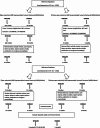Surgical approaches for open reduction and pinning in severely displaced supracondylar humerus fractures in children: a systematic review
- PMID: 21455471
- PMCID: PMC2839861
- DOI: 10.1007/s11832-010-0242-1
Surgical approaches for open reduction and pinning in severely displaced supracondylar humerus fractures in children: a systematic review
Abstract
Purpose: There is no clear evidence in the actual literature regarding which of the surgical approaches could bring about the best functional, cosmetic, and radiological outcomes, as well as fewer complications, when an open reduction and pinning of a severely displaced supracondylar humerus fracture is performed. We, therefore, performed a systematic review of the English literature to investigate the existing evidence regarding this issue.
Methods: A MEDLINE and EMBASE databases search was performed to identify articles that focused on the functional, cosmetic, and radiological outcomes, as well as post-surgical complications, regarding different surgical approaches used for open reduction and pinning in severely displaced supracondylar humerus fractures in children. One hundred and ninety-four articles were identified, of which seven were included for review. Data analysis included weighted means for all contingency tables and the Chi-square test. Standardized residues were studied when the Chi-square test was statistically significant. Statistical analyses were conducted using Stata 9.1/SE (StataCorp., College Station, TX) and P-values lower than 0.05 were considered to be statistically significant for all analyses.
Results: For functional outcome, a high frequency of excellent results was found within the lateral and medial approaches, and a high frequency of good results within the anterior approach. A high frequency of poor results was found within the posterior approach. For cosmetic outcome, there was a high frequency of fair results within the posterior and lateral approaches, and a high frequency of poor results within the posterior approach. No statistically significant difference regarding time to union, as well as complications, was found.
Conclusion: Our results suggest that a combined antero-medial approach could be the method which allows the achievement of better functional and cosmetic outcome according to Flynn's criteria. Time to union, as well as post-surgical complications, should not be an issue regarding surgical approaches used for open reduction and pinning in these fractures.
Keywords: Open reduction and pinning; Outcome; Post-surgical complications; Supracondylar humerus fracture; Surgical approaches.
Figures
References
-
- Kaewpornsawan K. Comparison between closed reduction with percutaneous pinning and open reduction with pinning in children with closed totally displaced supracondylar humeral fractures: a randomized controlled trial. J Pediatr Orthop B. 2001;10:131–137. - PubMed
-
- Aktekin CN, Toprak A, Ozturk AM, Altay M, Ozkurt B, Tabak AY. Open reduction via posterior triceps sparing approach in comparison with closed treatment of posteromedial displaced Gartland type III supracondylar humerus fractures. J Pediatr Orthop B. 2008;17:171–178. doi: 10.1097/BPB.0b013e3283046530. - DOI - PubMed
LinkOut - more resources
Full Text Sources


